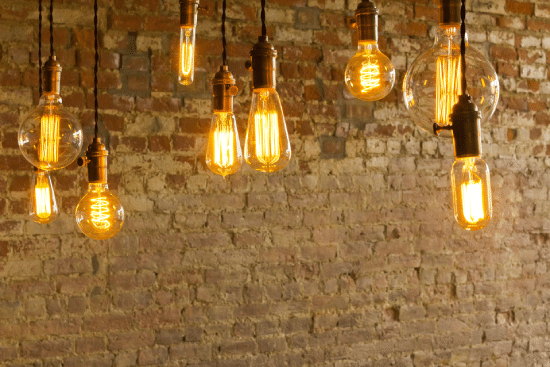What Are the Most Energy Efficient Light Bulbs?

Energy-efficient bulbs are not only good for the environment, but they also help cut utility bills. Many countries are phasing out traditional incandescent lights, and it’s thus a good idea that you know the energy-efficient bulb types available in the market today. Here is an informative piece to guide you through.
1. Light Emitting Diodes
Light-emitting diodes, commonly known as LED lights, are one of today’s most energy-efficient bulbs. Previously, LEDs were limited to a single bulb application in penlights, Christmas lights, or instrumental panels’ electronics. Today, there are numerous LED light uses.
One main benefit of LED bulbs is that they last longer compared to other types. They work well both indoors and outdoors due to their high durability. If you are 25 or younger, chances are, you have never had to change a light bulb at home if your family uses LED bulbs. If treated right, an LED bulb can last for more than 20 years. This helps save a lot of energy used in bulb production.
Another significant feature of LEDs is that they streamline light in one direction compared to other bulb models that disperse light in a spherical manner. This creates a more direct illumination, reducing energy wastage. For table lamps, some LED models use diffuser lenses to disperse light around the room.
Additionally, LED bulbs don’t cause heat buildup in a house. The LEDs use diodes to produce light rather than converting heat into light. Therefore, these bulbs can use around two to seventeen watts of electricity, about 1/3 of what other bulbs use. The bulbs also minimize the time you need to run an air conditioner in your house, saving more energy.
The LEDs don’t contain hazardous materials, so it’s safe to dispose of them. A single LED bulb can prevent tons of greenhouse emissions in its lifetime, which is very beneficial to the environment. Some manufacturers are even producing ceiling fans with LED lights, a valuable addition to the house.
Today, homeowners are no longer limited by lighting varieties. You will find LED light fixtures in a variety of colors. Some even have innovative technology that enables you to dim the lights, turn them on or off, change bulb colors through a voice command on an app. Other models are well compatible with security and occupancy features, which keeps your home safe while saving on energy.
One main disadvantage of LED lights is that they appear quite expensive than other models. However, if you have bought an LED bulb recently, you will notice a significant price reduction. Also, if you use the wrong light fixture and color, the light may seem too harsh. LED lights also give off more blue light than CFLs which can suppress sleep-facilitating hormones.
2. Compact Fluorescent Lamps
CFLs, compact fluorescent lamps, are other energy-efficient alternatives, especially in areas that require lights on for an extended period. This is also a great option if you don’t need full brightness. CFLs are pretty popular since they were the immediate replacement for the traditional incandescent lights.
The bulb contains mercury gas, and when activated by electricity, it produces invisible ultraviolet lights. The UV lights will then come into contact with a white coating inside the bulb and excites it to create visible light. CFLs directly produce light without generating heat, making them efficient.
One main benefit of ENERGY STAR-rated CFLs is that they can use around 50% to 75% less energy than incandescent bulbs. They can also last up to 10 times longer than incandescent, saving on disposal and production cost. Previously CFL bulbs could produce odd colored light. Today, with massive improvements, CFLs have evolved. You can find bulbs in various colors suitable for the bathroom, kitchen, and other rooms that require adequate lighting. These energy-efficient bulbs produce less heat compared to incandescent which helps you save on cooling costs. Additionally, CFLs cost much lower than LED bulbs.
One main disadvantage of CFLs is that you must carefully dispose of the bulb since mercury is harmful to humans and the environment. However, it’s worth noting that the bulbs don’t release mercury while in use. The problem only arises when improperly disposed of. Also, if you keep turning on and off the bulbs, it could shorten the lifespan. CFLs are slow to reach the full brightness, and they do not work well with dimmer switches.
3. Halogen Bulbs
Halogen bulbs also use less energy compared to traditional incandescent bulbs. These bulbs have a capsule inside which holds the halogen gas. When you light up the bulb, it heats the tungsten filament, and it evaporates into the halogen gas, producing a brighter light using less electricity. The evaporated tungsten will then get re-deposited to the filament. The reaction slows down the rate of filament wear, so it lasts longer.
Halogen bulbs produce the same light output as incandescent but use less energy. Although the halogen bulb’s energy efficiency may not match up with LEDs or CFLs, it’s a better alternative than incandescent. These bulbs are suitable options for outdoor applications where you need bright light.
Many halogen bulbs are about 10 to 20 times more energy-efficient than traditional options. Unlike the CFLs, the halogen bulbs don’t experience delayed warm-up, and they instantly emit lights. The halogen bulbs come in a variety of colors and are much cheaper than other energy-efficient bulbs.
The main problem with halogen bulbs is that they have faced stiff competition with more energy-efficient developments, and their production has begun to phase out. You might still find them on the shelves, though limited. Although halogen bulbs meet the federal minimum energy efficiency standards, there are better options that you can consider. Even high-rated halogen bulbs use more energy than the other efficient models, and they may run hotter, increasing your cooling bills. These bulbs also have a lower lifespan compared to LEDs and CFLs.
Bottom Line
Today, you have more choices when it comes to lighting your home efficiently. Different models and styles of energy-efficient bulbs enter the market each day. To pick the correct bulb, determine your desired brightness and choose a bulb based on wattage and lumen. Bulbs with similar wattage may have different brightness since the higher the lumen, the brighter a bulb is. You can also choose standard or dimmable lights based on your preferences. Select the desired color and shape of the bulb, compatible with your other lighting fixtures. Also, research well to determine the amount of heat produced by the bulbs to keep your cooling bills lower.
Should you need help with lighting installation, reach out to Brennan Electric. We have a team of technicians with the right tools, hands-on experience, and skills to handle small or large electrical projects. Our company also offers other services, including home electrical systems repairs, smoke alarms, and carbon monoxide detectors installations. We serve Seattle, WA, and the surrounding areas. Call us today to book an appointment and enjoy any of our services.

